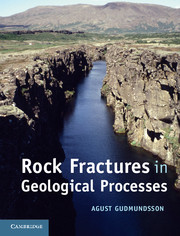Book contents
- Frontmatter
- Contents
- Preface
- Acknowledgements
- 1 Introduction
- 2 Stress
- 3 Displacement and strain
- 4 Relation between stress and strain
- 5 Loading of brittle rocks to failure
- 6 Stress concentration
- 7 Theories of brittle failure of rocks
- 8 Extension fractures and shear fractures
- 9 Displacements and driving stresses of fractures
- 10 Toughness and fracture mechanics
- 11 Field analysis of extension fractures
- 12 Field analysis of faults
- 13 Evolution of extension fractures
- 14 Evolution of faults
- 15 Fluid transport in rocks – the basics
- 16 Fluid transport in faults
- 17 Fluid transport in hydrofractures
- Appendix A Units, dimensions, and prefixes
- Appendix B The Greek alphabet
- Appendix C Some mathematical and physical constants
- Appendix D Elastic constants
- Appendix E Properties of some crustal materials
- Index
- References
14 - Evolution of faults
Published online by Cambridge University Press: 05 June 2012
- Frontmatter
- Contents
- Preface
- Acknowledgements
- 1 Introduction
- 2 Stress
- 3 Displacement and strain
- 4 Relation between stress and strain
- 5 Loading of brittle rocks to failure
- 6 Stress concentration
- 7 Theories of brittle failure of rocks
- 8 Extension fractures and shear fractures
- 9 Displacements and driving stresses of fractures
- 10 Toughness and fracture mechanics
- 11 Field analysis of extension fractures
- 12 Field analysis of faults
- 13 Evolution of extension fractures
- 14 Evolution of faults
- 15 Fluid transport in rocks – the basics
- 16 Fluid transport in faults
- 17 Fluid transport in hydrofractures
- Appendix A Units, dimensions, and prefixes
- Appendix B The Greek alphabet
- Appendix C Some mathematical and physical constants
- Appendix D Elastic constants
- Appendix E Properties of some crustal materials
- Index
- References
Summary
Aims
How faults transport crustal fluids is important in many fields of earth sciences, such as petroleum geology, geothermal research, volcanology, seismology, and hydrogeology. In order to understand the permeability evolution and maintenance of a fault zone, its internal hydromechanical structure and associated local stresses and mechanical properties must be known. The internal structure and, therefore, the local stresses in turn depend to a large degree on how the fault zone develops through time. The principal aims of this chapter are to present the current understanding of:
How faults initiate and grow.
The formation and development of the fault core.
The formation and development of the fault damage zone.
Local stresses within fault zones and their effects on permeability.
The evolution of fault slip.
Initiation of faults
General
Faults, like any other tectonic fractures, initiate from existing weaknesses in the rock. Most weaknesses are joints and contacts/interfaces of various types. The basic theory of fracture initiation, including that of faults, is due to Griffith (1924). Earlier, the Griffith theory was discussed in connection with rock failure (Chapter 7), fracture mechanics (Chapter 10), and the maximum depth of tension fractures (Chapter 8). Here we use Griffith theory to explain the initiation of shear fractures from existing joints and other weaknesses in the host rock.
- Type
- Chapter
- Information
- Rock Fractures in Geological Processes , pp. 416 - 465Publisher: Cambridge University PressPrint publication year: 2011
References
- 1
- Cited by



